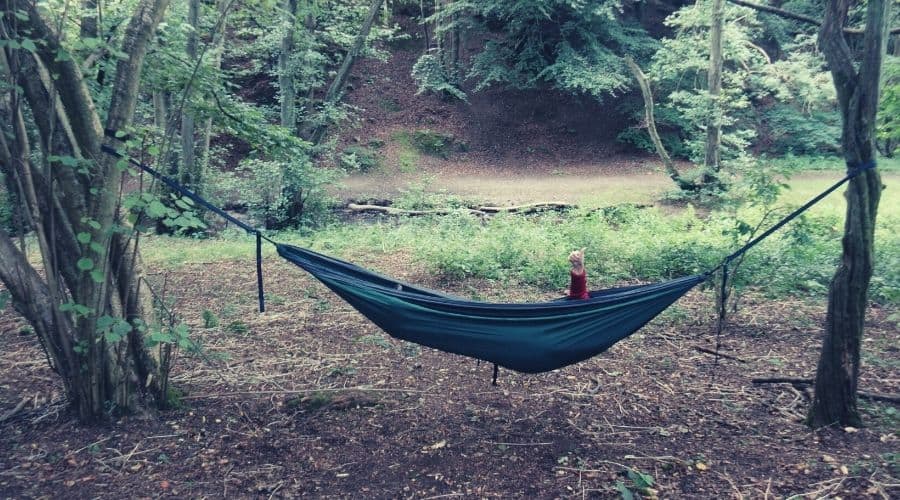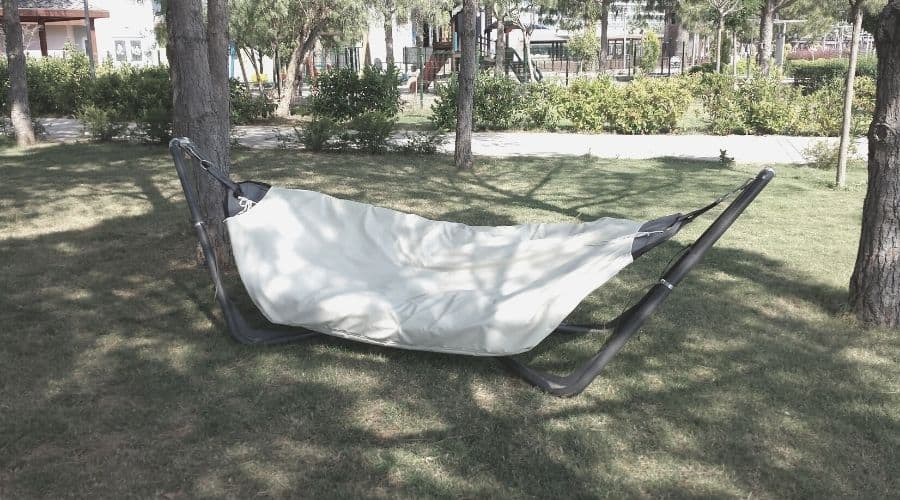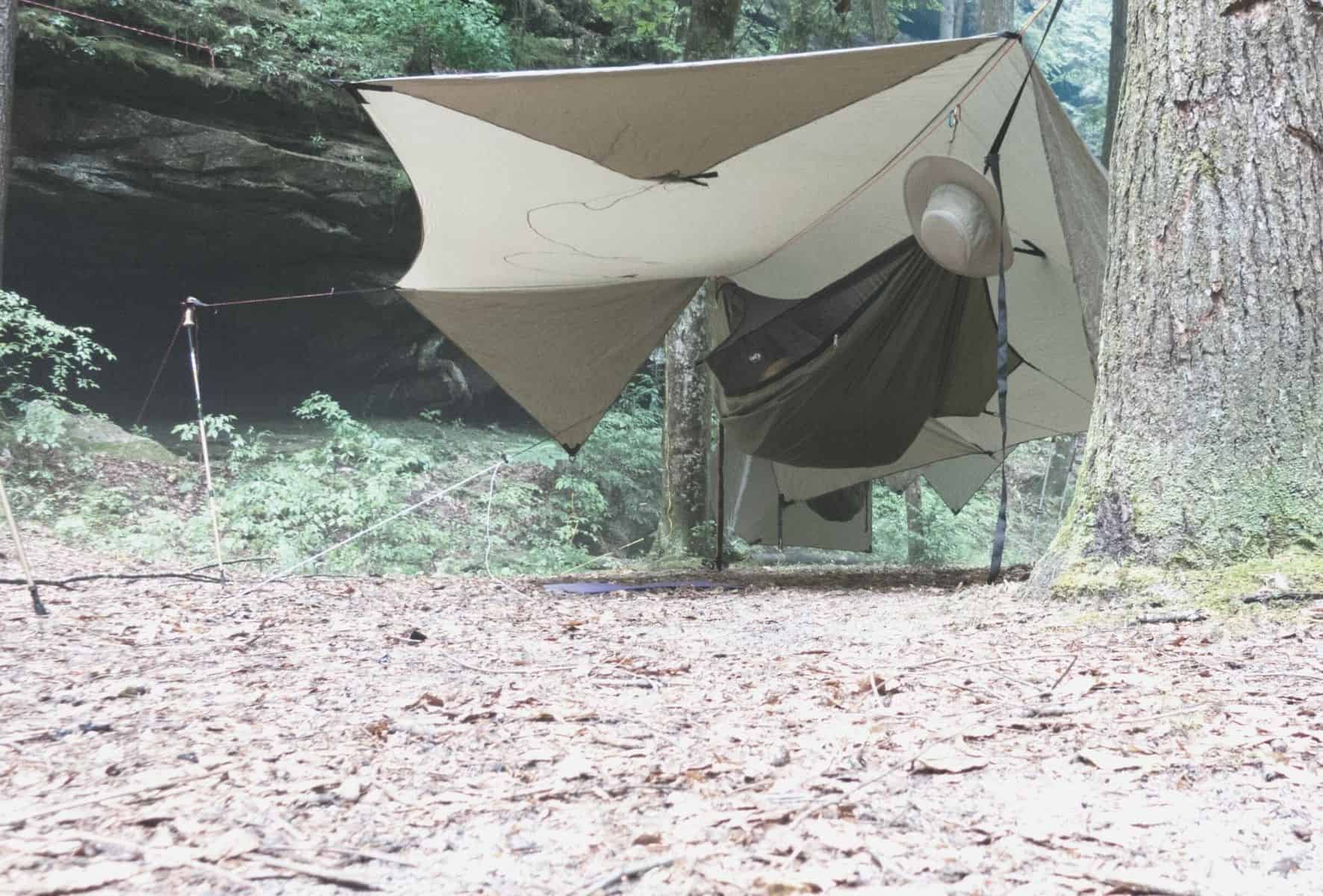Introduction
Want to Learn How to Hang a Hammock Correctly
You’re in the right place! In this guide, we will be covering the following:
- Learn how to choose the perfect pitch for hammock hanging
- Understand the best angle and height to hang a hammock
- Know how to hang your hammock safely and securely both at home and in the wild
- Learn how to hang a hammock responsibly
The difference between a hammock camping trip or hammocking session that’s memorable for the right reasons as opposed to the wrong ones comes down to three things: weather, location, and how well you do your hanging.
While the first of these is largely outwith your control and the second’s a matter of choice, the latter – how you hang your hammock – can be easily mastered with just a little bit of know-how and practice.
In this article, we’ll show you how it’s done with a straight-talking, simple guide to how to hang a hammock.
Hang Basics – Determining the Best Angle & Height
When doing your hammock hanging, following a few general rules regarding distance, height, and hang angle can help make sure your setup is as safe as possible.
- Choose two trees roughly 12-15 feet distance apart
- Anchor your tree straps to both trees around 5/6 feet distance from the ground
- Once you’ve attached your suspension system and hammock, weight your hammock with a backpack, rock, or friend
- Check that there is roughly a 30-degree angle between the tree and the tree straps on the lower side – any less and hammock will be too taut, any more and the hammock will sag
- Once in the hammock, check that the bottom of the hammock is around 18-20 inches from the ground – this should give the desired 30-degree angle between the tree straps and trees (but naturally depends on the weight of the hammocker)
- Any doubts? Check out this awesome, hugely handy hang calculator from HammockUniverse

Where to Hang Your Hammock?
Location, location, location!
Where you hang, your hammock is vitally important. This isn’t only because the location determines how good your views will be while “hanging out,” but also as regards how safe your hammocking sessions will be.
There are a few general rules that should be followed:
- Choose a pitch that’s at least 200 feet distance from water sources
- Make sure the trees you’re anchoring your hammock to aren’t home to any wildlife you might disturb
- Select two healthy, sturdy trees
- Inspect the tree canopy for any “widow-makers,” – i.e., large, rotten branches that wind or rain might cause to fall on your hammock while you’re in there
- Opt for a pitch where the hammock will hang over grass or earth (as opposed to rocks or hard roots) to make sure you’ll have a soft landing in the unlikely event of gear failure

Hanging Your Hammock From Trees
By far, the safest and most practical way to hang your hammock is by anchoring it to two trees. There are two ways in which this can be done – with rope and with straps.
Hanging Your Hammock with Rope
Because rope has a thinner diameter than hammock straps, it is more likely to cause damage to the trees. However, it’s far easier to make knots with ropes, and by taking a few precautions, you can use ropes safely and without damaging trees.

Here’s how it’s done:
1. Source 2 lengths of dynamic or static rope measuring 8-12mm in diameter (the thicker the rope, the less likely it is to harm your trees) and 8-10 feet in length
2. Tie a knot in one end of the rope to create a “bight” (loop) – a hangman’s knot or simple overhand knotwork best
3. Wrap the rope around the tree at head height on the tree and feed the unknotted end through the bight/loop
4. Pull the rope taut, so it stays in place
5. Create a second bight/loop on your rope where you expect to attach it to the S-hook, carabiner, or attachment point on your hammock. In this case, a simple overhand knot on a bight is the most practical option.
6. Repeat the process with your second tree and length of rope and adjust the loops as need be until you have the desired degree of tension.
Hanging Your Tree Hammock with Straps
If you want to hang your hammock with straps, they come in two broad configurations: daisy chain and standard straps.
Hammock hanging with Standard Straps

1. Wrap the strap around the tree, taking care to ensure there are no twists, and the fabric lies flat against the tree.

2. Feed the attachment point through the loop.
3. Pull the strap tight around the tree.
4. Attach the attachment point (carabiner/S-hook) to your hammock.

5. If there is too much slack in the system and your hammock is sagging, start again and wrap the strap around the tree again before passing it through the loop.
Hanging with Daisy Chain Straps
1. Wrap the strap around the tree, taking care to ensure there are no twists and fabric lies flat against the tree.
2. Feed one end through the last loop on the opposing end.
3. Pull the strap tight around the tree.
4. Attach the strap to your hammock using the S-hook or carabiner.
5. Adjust the tension as required by shifting the carabiner/S-hook up or down a loop.
Further reading: If you’re out in the wild and can’t find two suitable trees – don’t fret, as we show you how easy it is hanging a hammock without trees.
Hanging your hammock at home
If you want to hang your hammock at home, there are a handful of ways in which you can do so.
While most tree hammocks intended for use in the backcountry use carabiner or S-hook attachments, models designed for use in the yard, car camping, or elsewhere around the home use a wide variety of hardware. As such, before we get down to describing how to hang your hammock at home, let’s start with a brief intro to hammock hardware.

Hammock Hardware: Terminology and Usage
Most hammocks and suspension systems come with hardware that can be used to connect the suspension system to the wall and the hammock to the suspension system. The most common include:
- Ring buckles – Also known as “D-rings,” these semicircular rings are most commonly used to attach the end of the hammock to the suspension straps with a carabiner or S-hook
- J-Hooks – These two-part hooks are handy for hanging hammocks on porches, sheds, or inside your home. The first part of the hook consists of a screw that can be inserted into your wall, and the second part a hook connected to the screw by a pair of closed rings. If using a j-hook, be sure to screw it into a solid surface and ensure you screw it in deep enough to hold the weight of the hammocker.
- S-Hooks – These S-shaped hooks are often used instead of carabiners to connect the hammock to the suspension straps but are less reliable and secure due to being open-ended on both sides.
- Chains – Often used in the top and tail of hammocks intended for use at home, chains are heavy but highly reliable, secure, and easy to adjust when tweaking your setup to find the ideal tension.
NOTE: Using the above hardware to hang your hammock is far easier than using hammock knots (which increase manual effort both during setup and when making adjustments) but can also cause serious damage to trees. To ensure your setup is as eco-friendly as possible, use an old cloth or even a t-shirt to protect trees at any points of contact.
How to hang a Hammock on a Porch
1. Assemble all of your gear. To hang your hammock on your porch, you’ll need your hammock, two straps, attachment hardware (carabiners or S-hooks), and J-hooks if your porch doesn’t have two sturdy columns/stanchions/poles/banisters around which you can wrap your hammock tree straps.
2. Choose two points at head height (5-6 feet from the ground), ideally 12-15 feet apart, where you can affix your J-hooks.
3. Screw-in your J-hooks.
4. Attach the hooked end of the J-hooks directly to your hammock (on a smaller porch) or your suspension straps by placing the looped end of the straps into the hook.
5. Check the angles in your hammock, as described above.
6. Weight your hammock to test out your J-hooks’ solidity, gradually building up the weight until similar to the poundage of the would-be hammocker.
7. All being well with step 6, try the hammock out for yourself, making sure to transition your weight in slowly.

Hang Your Hammock From Poles
The procedure for hammocks from poles is all but identical to the process for hanging your hammock from trees, with the exception that you don’t have to recon for any wildlife you might be disturbing!
1. Wrap your strap around the first pole.
2. Feed the attachment end though the looped end of the strap.
3. Pull the strap tight around the pole.
4. Attach the strap to your hammock with the S-ring/carabiner.
5. Repeat steps 1-4 on the other side.
6. Weight the hammock.
7. Check your angles and make any adjustments.
8. Test for solidity by gradually transferring your weight into the hammock.

Purchase a Hammock Stand
Portable hammock stands aren’t cheap. However, they are ideal for porches, patios, balconies, yards, or anywhere else where upright anchor points are in short supply. Other benefits to owning a hammock stand are that they can be moved wherever you like and save you boring holes into walls or your patio when fixing J-hooks or other anchors.
In most cases, hammock stands come with a hammock. If the model you buy doesn’t, or you’re just too attached to your regular hammock to “hang out” with another, here’s how to go about using your old hammock with a new hammock stand:
1. Detach the supplied hammock.
2. Measure your hammock against the supplied hammock.
3. If your hammock is shorter than the supplied hammock, either use your straps to lengthen your hammock on both sides (doing so ensures equal weight distribution and means the hammock will be centered appropriately) or create a pair of simple extension slings with a length of rope/cord using a double fisherman’s knot.
4. If your hammock is too long (meaning it will sag in the stand), you can either tie a knot at either end of the attachment cord, at the end of the hammock (if it has these) or tie a knot at the end of the hammock fabric itself, both of which will shave off a few inches from the overall length.
Conclusion
Hanging your hammock – at home or in the wild – needn’t be something to be daunted by. Sure, get it wrong, and you could be in for a rude awakening during your afternoon nap or in the middle of the night. But by following the above instructions, you’ve already taken the most significant step to becoming a hammock pitching pro. Now, all it takes is a little bit of practice…
How did you like our article? If you have any comments or questions, please feel free to post them in the box below. And if you’d like to share it with your friends, do so!

